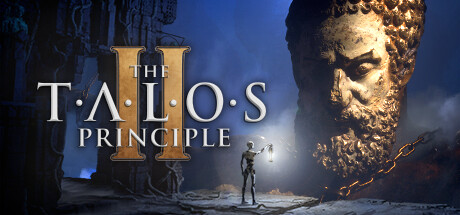So this dropped out of nowhere, like, I saw Icely Puzzles post a video about there being a (apparently temporary?) Demo for this game, and immediately went and played it before watching, and I’ll just say, I’m impressed they managed to create a sequel to this game after the ending of the first. Either way this one is just as good. In terms of spoilers, I’m only going to talk about things in the Prologue chapter, and first main puzzle area.
The game starts off in a very familiar setting. In ELOHIM’s garden, with puzzles to solve, though it skips past unlocking mechanics and just gives you basic puzzles with most of the puzzle mechanics and elements from the first game to reintroduce/tutorialise them for new players. Very notably, the recorder is not present, which frankly I find a great improvement. Croteam saw what worked from the first game, what didn’t, and axed what didn’t. Like the recorder, and the axe.
But within the first hour or less, everything you know changes. You see, ELOHIM’s simulation is your dream now, not your reality, because your reality is now, well, reality. You awaken at the dam from the ascention ending of Talos Principle 1, and you find out that you’re then 1000th person born into the new humanity, and that this game takes place millenia after the end of the first game. They have built a city with politics, philosophy, art, and also energy problems. It was going so well, oops.
Anyway a projection of Prometheus beckons you to adventure before being chained and pulled away by Pandora, so you and 4 other robots all go to investigate, and turns out the new island is a lot like the simulation in structure: solve spacial reasoning puzzles to collect,,, something,,, and then use that to solve tetromino puzzles and access mysterious towers. The puzzles are why we’re here, but the biggest draw is the mystery behind it all. Who, or what, is Prometheus? Who created these puzzles? Why didn’t Prometheus beckon new humanity until after your birth?
It’s a fantastic story so far (I’m about half way through as of writing) and the puzzles, while slightly easier currently than the original game, introduce creative new mechanics and explores their interactions and uses. I do have some gripes with some mechanics, but so far it’s been a blast.
The game does not have a hint system, but arguably neither did the first one without going way far out of your way for it. Instead exploration will lead you to orange Decryption Keys, which you can spend to bypass puzzles instead of solving them. There is a limited number of keys, and the only way to retrieve them once spent is to complete the puzzle properly, after which your key gets refunded.
The game does have an optional navigation hint system in the form of a compass that shows you landmarks such as puzzles, points of interest, and the entrance of each puzzle area. There are options both to disable this compass completely, or have it also display question marks for points of interest you may have missed. Each hub area is drastically larger than in the original games, and each hub contains 11 puzzles. 8 that are are numbred and signposted in the game world, 2 hidden ones that you’ll have to explore to find, and one golden puzzle that is end-game stuff I’ve not reached yet, so I have no idea what they are for.
Lastly, I’ve not seen any mines yet or puzzles that are easy to softlock in, which is nice because a restart causes a full map reload now instead of a near instant rewind. Croteam actually nods to this in some exposition at the start claiming that mines didn’t exist as part of the simulation to begin with and ELOHIM created them independently to fuck with us.
Steam: https://store.steampowered.com/app/835960 £24.99

Leave a Reply